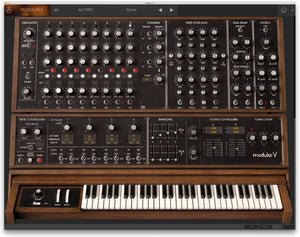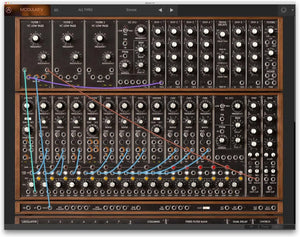Your Cart is Empty


Description
Arturia, in partnership with Bob Moog, has made a faithful reproduction of one of the most famous series of synthesizers: Moog Modular. Whether recreating the abstract tonal qualities of the classic electronic soundtracks, or pushing forward the sonic boundaries of today, the Moog Modular V is the synthesizer of choice for sound exploration, anywhere, anytime. It has all the vibe and the fat sound of the original, cleverly combined with important contemporary features like polyphony, MIDI control, loading and saving of patches...
MAIN FEATURES:
- Switch to Syncrosoft copy protection
- VCF audio quality improvements
- lower CPU utilization on Mac OSX
- All the parameters of the original Moog Modular: 9 oscillators, 2 LFOs, 3 filter slots, 1 Noise Generator, 6 envelopes, 2 VCAs
- 16 auxiliary VCAs with modulation inputs
- 24-step sequencer
- 1 filter bank (14 bandwidths available)
- More than 600 presets, made by professionals, more...
- aliasing-free oscillators, at no extra CPU cost.
- better reproduction of analog oscillators: the condensers' unload and the oscillators' instability are simulated, helping to reproduce a typical warm sound.
- very accurate reproduction of the legendary Moog 24 dB low-pass filter.
- implementation of soft clipping, i.e. reproduction of the filters' current limiting function.
- VCF audio quality improvements.
- better Audio Unit compatibility (Digital Performer most notably).
- ability to use NRPN MIDI messages for automation.
- better handling of control surfaces while changing preset.
- midi RPN "pitch bend range" message is now recognized.
- One unique scrollable view to overlook the entire synth.
- Some of the modules are now interchangeable, allowing to configure - to a certain extent - the Modular the desired way.
- Improvements on the oscillators (new free running), on the filters (better response to modulations), on the envelopes (faster and even closer to true analogical behaviour).
- New Unison mode
- New Audio-In possibilities
- The Soft-clipping emulation is now done on each mixer and not systematically on all of them, which saves on CPU load.
- 1630 Bode Frequency Shifter. Developed under the Moog license by Harold Bode in 1964, it is extremely rare (a dozen Worldwide).
- 928 Sample and hold is also very rare. Originally assembled in a separate cabinet, it was adapted on the last modular series, in the late 70's.
- 912 Envelope follower (or Schmit Trigger). One of the most popular modules on the Moog systems, it was often added to original configuration to create complex modulation through the use of an output signal.
- 12 stage phaser. The Moog 12 Stage Phaser was very well known, and originally conceived as an external rack to the Modular systems.
- Formant Filter. A new module developed by Arturia, which did not exist on the original Moog systems. It allows the filtering of sounds according to the formants a, e, i, o, u.
- Ring Modulator. Also a new module developed by Arturia, it creates very metallic sounds.
- 200 new presets to provide optimal use of the new modules.
Tech Specs
Platform specifications
Windows
- Win 10+ (64bit)
- 4 GB RAM
- 4 cores CPU, 3.4 GHz (4.0 GHz Turbo-boost)
- 3GB free hard disk space
- OpenGL 2.0 compatible GPU
- ARM processors not supported on Windows
Apple
- Mac OS 11+
- 4 GB RAM
- 4 cores CPU, 3.4 GHz (4.0 GHz Turbo-boost) or M1 CPU
- 3GB free hard disk space
- OpenGL 2.0 compatible GPU
Work with ASC
An elegant and simple solution to help you install, activate, and update your Arturia software instruments.
Required configuration
Works in Standalone, VST, AAX, Audio Unit, NKS (64-bit DAWs only).





